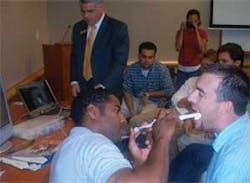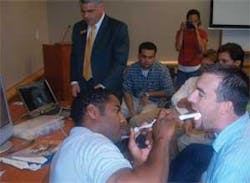From the ivory tower:Biodontics: Promoting early adopters
By Edward F. Rossomando, DDS, PhD, MS, and Mathew Moura
Early adopters, according to Everett Rogers, are defined as a segment of the population that tends to buy or try out new technologies, programs, and versions of existing programs sooner than the general population. Early adopters are theorized as critical to the success or failure of a new dental diagnostic or therapeutic introduced into the market. Their function is to buy, assess, and bring to the attention of others in a field of new technology and innovation.
Historically, dentists are not early adopters. For example, approximately 30 years were required for the profession to accept X-rays. Wilhelm Roentgen discovered X-rays in 1895, however, in 1913, not a single dental school in the United States taught radiography. Physicians had made use of X-rays for many years, and a Philadelphia physician had even presented a lecture to that city’s dental society in 1918 entitled “The advantages of X-rays in dentistry.” It would not be until after Dr. William Gies’ 1926 report that dental schools would teach radiography courses.
Because dental schools began teaching radiography after 1926 and X-ray machines were in dental practices by the 1930s, it is tempting to speculate on the relationship between the teaching of the topic, radiology, and acceptance of the new technology by dentists. Is it a coincidence or is there a causal relationship between the use of a new technology in dental school and its acceptance into dental practice? To test the latter, a dental education program was designed to explore the relationship between teaching and acceptance of new technologies and innovations.
The Biodontics Educational Program (BEP) at the University of Connecticut School of Dental Medicine was introduced to expose dental students to new diagnostics and treatment products and equipment. Supported in part by a grant from the National Institute of Dental and Craniofacial Research (NIDCR), the program was presented in 2005, 2006, and again in 2007, to dental students from the University of Connecticut, Marquette University, Howard University, the University of Southern California, New York University, and the Meharry Medical College. In all, nearly 70 dental students have participated.
The BEP curriculum introduces early adoption and experience in the use of these principles for decisions related to selecting and evaluating new technologies. The dental industry has been a strong supporter to the BEP. Some of the participants and companies include Susan Ferrante and Debra Fleming of Colgate Palmolive, Inc.; Michael Harris and Elizabeth Roberts of Johnson & Johnson; Dr. Arthur Ashman, founder of Bioplant Inc.; Dr. Jeffery Hillman, a founder of Oragenics; William Dragan, president of Centrix; James Mandell, Pentron, Inc.; Paul Wennerholm, Patterson Dental; and Jon Horn, Benco Dental. Additionally included are Joseph Sakaduski of Sakaduski Marketing Solutions, Inc., and Garret Ludwig of Diversified Design Technologies, Inc.
By providing BEP Fellows with a full understanding of an innovative diagnostic tool or treatment from its conception to its introduction onto the market, the BEP hopes to increase the number of early adopters. Teaching students innovations in dental school hopefully will allow them to more easily incorporate innovative diagnostics and therapies into their practices. The BEP curriculum is designed to graduate dentists who are more inclined to accept new products and technologies, and promote the transfer of new discoveries from the research laboratory to dental practice.
Editor’s Note:Dr. Rossomando is the professor and director of the Center for Research and Education in Technology Evaluation (CRETE) and the University of Connecticut School of Dental Medicine in Farmington, Conn. Reach him by e-mail at [email protected].


